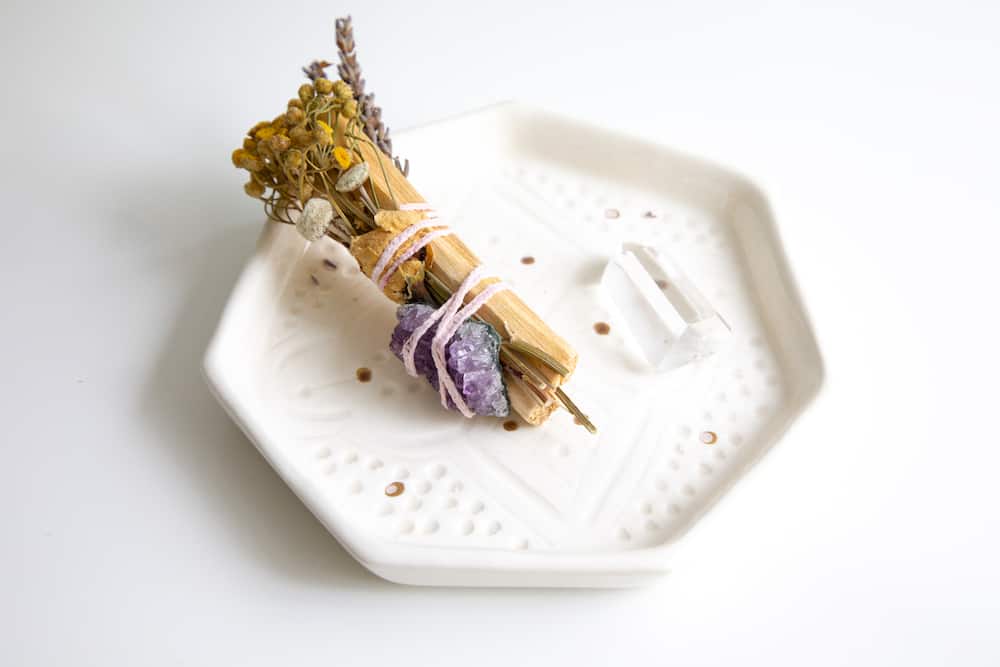If you’ve ever attended a yoga class, a meditation group, or a holistic therapy session, there’s a high chance that you’ve encountered palo santo. The scent is unmistakable – woody, warm – but the facts surrounding this South American incense stick have been hazy ever since it hit the wellness mainstream. Here, we break down what it’s about and how to use it responsibly.
What is palo santo and where’s it from?
Palo santo (which translates into English as ‘holy wood’) is wood from the bursera graveolens tree, native to South America. It grows in dry, tropical forest areas, and the majority of it is found in Ecuador. It has been used (through the practice of smudging) to clear energy for thousands of years within indigenous cultures.

What are the benefits of palo santo?
Indigenous groups maintain that the smoke from the wood, which is burnt during spiritual ceremonies, carries medicinal properties. They believe that burning palo santo can remove any negative residue or trapped energy. There’s a belief that when you remove loaded energy from yourself or from a space, you’re able to take a more neutral approach to life, which in turn leads to better relationships and reactions.
As sustainable e-commerce brand Green Gaea knows, palo santo can do that and much more. The company, which sells handmade goods in a bid to support the environment and social enterprises, offers herb bundles featuring palo santo, and cite the sacred wood as a promoter of positive, joyful feelings.
Is it sustainable?
This is where it can get tricky. Times have changed since ancient civilisations called upon natural remedies within the areas they lived; the demand now is much greater and spans much wider. Meaning that there’s often unsavoury, unethical practices going on in order to meet these demands and make a profit.
For palo santo to be harvested, the branches of a tree or the tree itself have to die of natural causes. Then it has to be left for around five to eight years so that the oils in the wood can mature enough to create incense. Once this happens, the wood is processed into sticks.
The lengthy nature of this process has led to some companies sourcing their palo santo from trees that have been prematurely killed or from healthy trees. These practices, which also often include illegal importation, mean that the eco-system is being abused. And, in the latter case, the wood that ends up in stores is not authentic palo santo. It has also been found that some companies are producing the wood synthetically, using chemicals to recreate the scent.
The bursera graveolens tree isn’t endangered (as confirmed last year by the International Union for Conservation of Nature), but its habitat – tropical dry forest – is under threat. It has been abused by people logging or clearing trees in order to use the land for other purposes, such as farming.
This is why it’s so important to know where your palo santo comes from and if the company behind it is working with local communities and adhering to the regulations. Green Gaea is transparent about their Palo Santo: it’s 100 per cent ethically sourced from farmland in Ecuador by their artisan partners, Luna Sundara, who travel to the region and meet with local farmers.
How do I use palo santo?
Smudging has become a popular practice today, with wellness enthusiasts using sage and palo santo to purify their homes. Briefly, smudging involves lighting and wafting the smoke of slow-burning herbs/woods around the home or the self in order to clear trapped or negative energy or prepare for a spiritual ceremony. However, as with every ancient tradition brought to today’s world, it’s important to take the time to understand the what’s, how’s, and why’s. Cultural appropriation is rife today, and it often threatens the existence of the groups and cultures from whom popular traditions originate.
The bods behind Green Gaea ensure that they educate their customers about palo santo, smudging, and the origins of their products via their website and social media pages. They sell their ethically sourced palo santo sticks in different bundles, depending on what the customer is looking for. Other natural offerings that come with their palo santo sticks include lavender, blue sage, wildflowers, and crystals; all of which have their own wellness properties.
To ensure you’re both buying and using palo santo responsibly, education is key. Do your research on where your palo santo comes from and how, why, and when it’s traditionally used.
This article is brought to you in collaboration with Green Gaea

